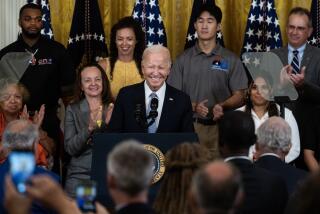Pssst ... Want to buy some insulin or other lifesaving medicine? Go to Canada

PARRY SOUND, Canada — Last week, I walked into a small-town pharmacy in rural Canada in search of lifesaving medicine: insulin.
I don’t suffer from diabetes. But an estimated 30 million Americans do, and 1.5 million of them need insulin injections to stay alive. They’re facing a catastrophe: the price of insulin has nearly tripled over the last decade. Many cash-strapped diabetics without good insurance have resorted to rationing their supply. Some have died.
That shouldn’t happen in the world’s richest country. Nor does it need to happen. The proof is next door in Canada.
At Pollard’s Pharmacy in Parry Sound, Ontario, I asked if I could buy a 10 milliliter vial of Humalog, a fast-acting form of insulin that retails for $280 in Los Angeles.
“Sure,” the pharmacist said, and pulled a tiny bottle out of the refrigerator. The price was about $33 in U.S. dollars, roughly 12% of the U.S. price.
“Pretty good price,” I said.
He laughed. “The government regulates what we charge,” he said.
No prescription required, either.
“Who’s going to buy insulin if they don’t need it?” he said. (He asked not to be identified by name; “I’m a pharmacist, not a policy expert.”)
I asked for a price check on another medicine: Ciprodex, an antibiotic I recently used for an ear infection. I paid $255 at home with a prescription. In Canada, I could buy the same drug for about $49 with a prescription from a local doctor.
The reason for those dramatic gaps in cost is simple: Canada’s federal government imposes price ceilings on prescription drugs.
Under Canadian law, the government can declare high prices an illegal abuse of patient rights. Drug companies can challenge the rulings, but they usually settle without court proceedings. Despite Canada’s low prices, their drug companies still manage to turn a profit. Prices are even lower in most European countries.
The United States, by contrast, places few restrictions on what drug companies can charge.
Thanks to brilliant lobbying by the pharmaceutical industry, federal law even prohibits Medicare, a major buyer of drugs, from using its purchasing power to negotiate prices directly. Manufacturers negotiate with private health insurers, but that’s a secretive process that produces the highest prices in the world.
It’s a system that gives the industry the benefits of a free market, but strips consumers (including the government) of bargaining power.
No wonder many Americans, especially from border states such as Minnesota and Vermont, are heading north to buy their prescriptions. It’s illegal to bring the drugs home, but hardly anyone is prosecuted.
And no wonder so many politicians, including Bernie Sanders and President Trump, have stampeded toward what looks like an easy solution: Allow U.S. drugstores to import drugs from Canada.
Last month, Trump announced that he’s ordered the Department of Health and Human Services to propose rules under which states, wholesalers and pharmacies could buy from Canada.
It sounded like a smart idea — but it’s not.
First, the plan Trump announced won’t cover some of the most expensive drugs, including modern forms of insulin and many cancer medicines. If you need insulin to stay alive, the president’s proposal is a Potemkin drug plan: a shiny facade with nothing behind it.
Trump didn’t actually change the rules; he merely asked HHS to support “pilot programs” in states that want to try importing drugs. It may take years before any plans are up and running, and that’s if the pharmaceutical industry doesn’t succeed in stopping them first. (The head of PhRMA, the big drug industry lobby, denounced the proposed plans as “failed polices” that could “jeopardize public safety.”)
Even then, Trump’s rules won’t allow individuals to buy across the border. It’s aimed at states, wholesalers and pharmacies, so the Food and Drug Administration can make sure the drugs are legitimate. Some internet sites offer pharmaceuticals from Canada, but consumer watchdogs warn that it’s hard to be sure where the drugs really come from.
Second, we forgot to ask Canada what it thinks — and Canada isn’t capable of supplying the whole U.S. market. There are more than 329 million people in the United States; Canada’s population is 37 million, smaller than California’s. The Canadian pharmaceutical sector was never designed to handle our needs.
When Trump announced his proposal, Canadian politicians and media organizations freaked out. “Donald Trump, keep your hands off our drugs,” Toronto’s Globe and Mail editorialized.
Prime Minister Justin Trudeau, who’s running for reelection this year, may make universal drug coverage part of his campaign. Under current law, most prescriptions are already free for Canadians under 26 or over 65; those in between have to buy private drug insurance or pay out of pocket.
Now he also has to come up with a way to fend off drug shortages if American pharmacies invade.
And that’s the real point: There’s something deeply disturbing about Congress and the federal government standing powerless before its drug companies and relying on little Canada to bail us out.
Are price ceilings the answer? Universal drug insurance? Better, more transparent subsidies for low-income patients? Freeing Medicare to negotiate prices down? Making it easier to bring cheaper generic drugs to market?
Maybe all of the above. We’re a big, smart, entrepreneurial country — at least, we used to be. We ought to be capable of solving this problem on our own.
More to Read
Get the L.A. Times Politics newsletter
Deeply reported insights into legislation, politics and policy from Sacramento, Washington and beyond. In your inbox three times per week.
You may occasionally receive promotional content from the Los Angeles Times.











